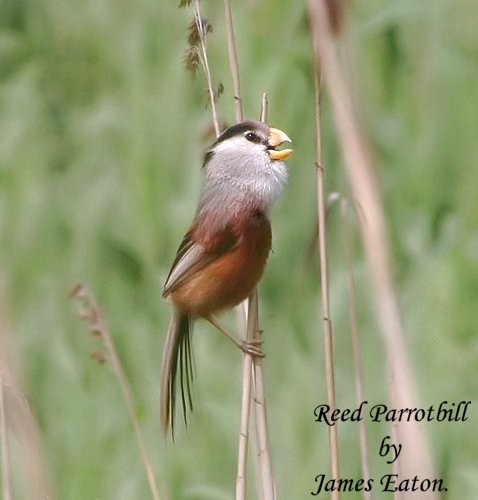Alternative names: Heude's Parrotbill; Chinese Parrotbill; Chinese Crowtit; Yangtze Parrotbill
- Calamornis heudei
Paradoxornis heudei
Includes: Northern Parrotbill
Identification
18 - 20cm. The only parrotbill with seasonal differences in plumage.
- Breeding:
- Crown to upper mantle plain slate grey
- Black lateral crownstripe from above eye to nape side
- Lower mantle to back dark chestnut
- Lower breast dark chestnut, lower flanks chestnut-tinged
- White eyering, whitish cheek to supercilium and throat side
- Yellow bill
- Non-breeding:
- Broadly streaked forehead and crown centre to nape with pinkish-cream and ash-grey
- Broad lateral crownstripe streaked black and rather warm brown
- Pale pinkish-cream ear-coverts
Sexes similar, juveniles are duller than adults.
Distribution
Found in eastern and northeastern China and adjacent southeastern Siberia.
Locally common.
Taxonomy
This is a polytypic species[1] consisting of 2 subspecies.
Subspecies
- C. h. polivanovi
- C. h. heudei
- Eastern China (southeastern Shandong south to Jiangsu, and inland to northern Jiangxi)
- Eastern China (southeastern Shandong south to Jiangsu, and inland to northern Jiangxi)
polivanovi was formerly recognized as full species (Northern Parrotbill). Another described subspecies mongolicus is usually not recognized.
Habitat
Found in lowland reedbeds.
Behaviour
Feeds on insects.
Usually seen moving through reedbeds in groups of 5 to 15 birds, sometimes more. During breeding season in pairs.
Breeding season from May to August. The nest is a beautiful cup-shaped structure made of strips of dead reed sheats. It's placed around 1.5m above the ground, among reeds and supported by two reed stems (like the one of Common Reed Warbler). Lays 2-5 eggs.
Resient species.
References
- Clements, J. F., T. S. Schulenberg, M. J. Iliff, D. Roberson, T. A. Fredericks, B. L. Sullivan, and C. L. Wood. 2014. The eBird/Clements checklist of birds of the world: Version 6.9., with updates to August 2014. Downloaded from http://www.birds.cornell.edu/clementschecklist/download/
- Del Hoyo, J, A Elliott, and D Christie, eds. 2007. Handbook of the Birds of the World. Volume 12: Picathartes to Tits and Chickadees. Barcelona: Lynx Edicions. ISBN 978-8496553422
- Gill, F and D Donsker (Eds). 2015. IOC World Bird Names (version 5.2). Available at http://www.worldbirdnames.org/.
Recommended Citation
- BirdForum Opus contributors. (2024) Reed Parrotbill. In: BirdForum, the forum for wild birds and birding. Retrieved 29 April 2024 from https://www.birdforum.net/opus/Reed_Parrotbill
External Links
GSearch checked for 2020 platform.1




